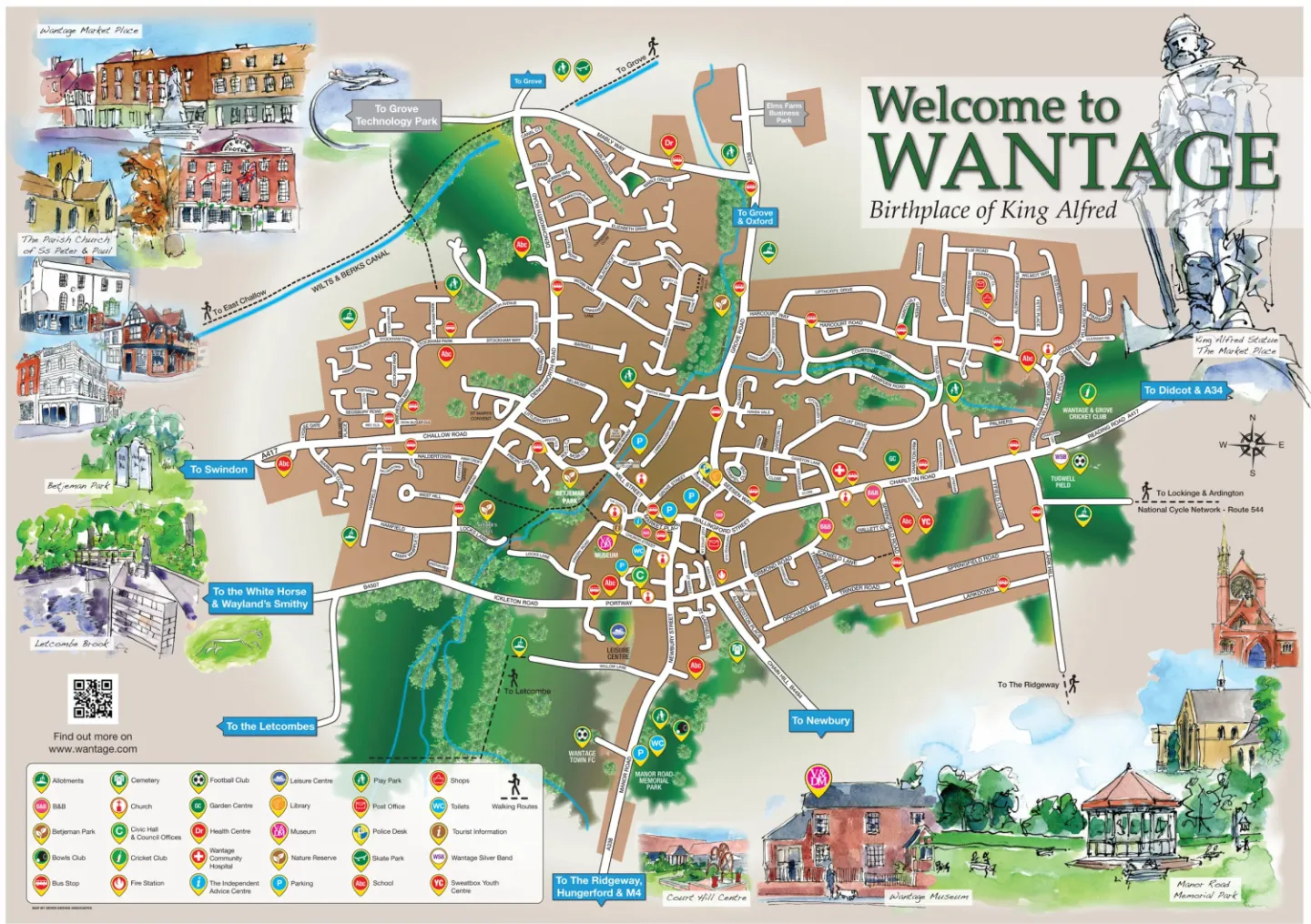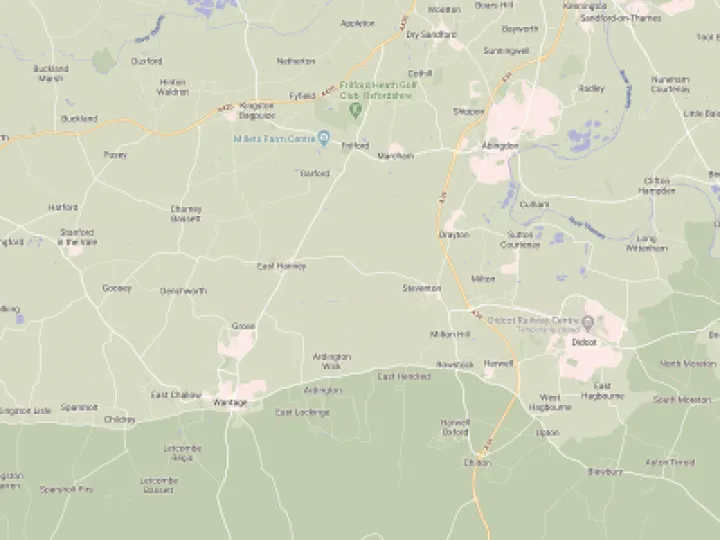Introduction to Wantage
Introduction to Wantage
By Trevor Hancock (9 min)
The track can be heard here: Introduction
More information about Trevor Hancock can be found here: Family and local history research
The text is as follows:
Wantage, an ancient market town in the Vale of the White Horse, Oxfordshire, is surrounded by arable and pasture land and beautiful villages. In his will, The West Saxon King Alfred the Great, born in Wantage in 849 AD, left the town to his wife Ealhswith. King Æthelred , summoned the army bishops, Abbots and earls to a manor known as Wantyngh for the purpose of deciding certain cases in 997 AD. There has always been speculation as to where the Saxon Villa was located. Dr. Wise, when writing to Dr. Mead in Oxford in 1738, highlighted the following site – a hollow way into the town from Faringdon with Grove Street and a little running water dividing the high garden from the lower, making three sides of an oblong square, and the river, the fourth. The ground may contain about six acres.
The Manor of Wantage was given to Fulk Fitzwarin by the Earl of Pembroke. The Fitzwarins came over with William, the Conqueror and held the manor for many years. A descendant was an Earl of Bath who erected a cross in the market place in 1580. Captain Symonds visited Wanatge with Charles I in 1644, and recorded a wording on the cross.
Sir Ivo Fitzwarin's will of 6th November 1412 left one mark to the poor tenants of Wantage Brian. Sir Ivo's daughter, Alice, was married to Whittington who became Lord Mayor of London and achieved fame and popularity in pantomime.
Fairs are held three times a year in the market place. The right to hold a weekly market in the town is recorded as having been granted by Henry III in 1216. In 1665, a proclamation was issued by the king prohibiting this keeping of the fairs at Wantage to stay the further infection from the plague. Rival armies were courted in or near Wantage during the civil war of 1643 to 1644.
The hiring fairs were abolished from 1873 under the Fairs Act of 1871, but reinstated in 1879. In 1597, an act was passed for investing the administration of these town land funds into the hands of 12 governors and revenues were used for relief of the poor, repair of the highways and support of the grammar school. Governors of town lands continue to operate in Wantage administrating Eagles and Mill Streets almshouses. The knuckle bones of cattle formed the sides of the footway into Stiles Almshouses, originally thought to be that of sheep, but analysis a few years ago proved otherwise.
Industries of the town were mostly related to the agricultural nature of the surrounding land. Opposite the mead were industrial buildings for cloth making. These were worked for many years by successive members of the Hazel family. Tallow chandries, malting, and milling all added to the prosperity of the town. Sacking cloth and twine facilities provided employment in Grove Street and Little Lane.
Tanneries were located near the Letcombe brook and parallel with Priory Road, which used to be called Tanner Street, and Brian's Brook, now Sterlings Road, taking advantage of the water in close proximity and readily available hides.
Transport of goods to and from the town was improved by the Wilts and Berks Canal, providing communication with London, Bath and Bristol, but also allowing easier access for people, thus changing the town. This is evident in the architecture of buildings. The method of transport of goods changed with the coming of the Great Western Railway in the mid-19th century, which led to the demise of the canal. With a station two and a half miles from the town, the construction of a tramway, was considered desirable to convey passengers and goods, at first horse-drawn, but soon becoming steam-powered. During the period 1800 to 1835, Wantage is supposed to have acquired a reputation due to the conditions in the town, both environmental and criminal, to be called black Wantage. This is in part due to the influx of people building the canal.
Recent analysis of the possible crime figures for this period suggest Wantage was no better or worse than any other county town in the UK at this time. To improve Wantage, local people applied and obtained an act of parliament in 1828. A board of commissioners was established for the supervision of the town, and improvement of drains, roads, policing, and lighting. Religion and education came to the fore during the Victorian period with a considerable benefit to the town and villages.
A 26 year old man, the Reverend William Butler, was appointed as vicar of Wantage in 1846. He had a bounding energy and a great interest in the people of the town and the education of children. As a result of his efforts, a national school for boys, girls and infants was built in Church Street in 1850. He also founded the community of St. Mary the Virgin, the convent near the camel crossroads. A new Baptist church was built in Mill Street. The congregation moving from a chapel in Church Street. There was also at one time a Baptist chapel in Gaston Lane where the Baptist cemetery is today. This is where John Bunyan preached one day in the 17th Century.
A Wesleyan church was built in Newbury Street with a school for young children. Roman Catholics had to travel to Hendred until they obtained a small building in Mill Street before their church was built in Charlton Road. Sir Robert Lloyd Lindsey, later Lord Wantage, was a major benefactor to the town. The presentation of a statue of King Alfred erected in the market place was an important event in the town's history. Many organizations have used the statute as a logo, and it has become a symbol of Wantage. Lord Wantage also purchased a site for a new town hall, which is built in the style of houses at Lockinge. His refurbishment of the building next door encouraged other owners to re-front their premises, the Bell Inn taking a lead.
An urban district council was formed towards the end of the 19th Century consisting of local businessmen who had a financial interest in the town, but ensured that improvements continued. The fire brigade was given a new station within the centre of the town for their new fire engines. Celebrations were held to welcome home men from WWI, captured on photographs by Percy Jones, who also became Secretary of the Comrades of the Great War, later becoming the Royal British Legion.
The 1930s were not a good time. The photographs taken during that decade indicated downturn in prosperity. Carnivals were held to pay off the debts acquired in providing a new hospital in Charlton Road, a cinema first in Wallingford Street, and later The Regent in Newbury Street brought new entertainment to the town and nearby villages.
WWII brought new challenges and visitors. Trips, including the Worcester Street Yeomanry were billeted in 1939/ 1940. A home guard was formed, and at Grove airfield, the Americans arrived in 1943. Following the war, the Ministry Supply established the Atomic Energy Research Establishment at Harwell and purchased the Charlton House grounds for employees' housing, bringing a renewed prosperity to businesses. However, it was the beginning of the end of Charlton as a farming village. The village of Grove was also in place to be targeted for redevelopment, the old airfield providing land for housing and the population rising to equal Wantage.
Wantage has retained its charm as a market town with the marketplace as a focal point. new developments, which is ongoing around the town is changing this community yet again.


